| View previous topic :: View next topic |
| Author |
Message |
Lagondanet
Administrator

Joined: 03 Jan 2007
Posts: 3110
Location: UK
|
 Posted: Tue Sep 08, 2009 1:03 pm Post subject: Oil/Water temperature sender units Posted: Tue Sep 08, 2009 1:03 pm Post subject: Oil/Water temperature sender units |
 |
|
In my experience these can often need frequent replacement. ie. they are not very reliable.
FYI David Peacock (13085) has sourced an alternative & I quote him
"The temperature sender units for both water and oil are the same.
I have used the ones supplied by Time Instruments Limited who
coincidentally are based in Newport Pagnell.tel:08701270020
These are available from Lark Speed (http://www.larkspeed.com/)
tel:01132643231
Tim Sender Unit for 12v Electric Water Temperature Gauge
but make sure you get the 3 adaptors in the pack as one of
them is the right size needed for the thread in the engine
block (water)or sump (oil).
The sender will work backwards when sending to the Lagonda
Dash (in fact its the Lagonda working backwards)but this just
means you will see -84 instead of 84 on the read out
The temp goes up to -86 and then my fans kick in
and the temp goes down to -83 then the fans stop these units
are accurate and last and cost £10.50."
http://www.larkspeed.com/index.pl?p=331099&a=i |
|
| Back to top |
|
 |
jonc
Joined: 21 Sep 2010
Posts: 584
Location: Cheshire, UK
|
 Posted: Sat Apr 28, 2012 2:22 pm Post subject: Posted: Sat Apr 28, 2012 2:22 pm Post subject: |
 |
|
Out of interest, what do people do about the temp senders?
There are (I think) five sensors:
* Water temp (38.14039 - to early 1982 / 38.18044 - early 1982 on / 38.26296 - VF dash)
* Oil temp (38.14039 / 38.20037 - CRT / 37.21872 - VF dash)
* Inside temp (38.14259)
* Outside temp (38.14259)
* External low temp warning (38.14040)
The inside and outside temp are the same and have a M16x1.5 thread (from memory). They appear to be PTC thermistors - positive temperature coefficient which means the resistance increases as the temp increases. I did some testing last year and 0 degrees C was 410 ohms with 100 degrees 700 ohms.
As David Peacock says, this is the reverse of the usual - cars normally use a negative temperature coefficient. I think this is because traditionally the sensor was used to drive a heater element around a bi-metallic strip in the gauge. Higher engine temperature gave a lower resistance which cause the heater element to get hotter - this bent the bi-metallic strip which deflected the gauge more.
I think between my two cars I have five faulty sensors. I recently got some prices:
38.18044 £215+VAT
38.14039 £235+VAT
..which made me think twice! The price is an indication that Aston Martin Heritage Parts are having these custom made for them - which says that there is now no equivalent.
So - what do you do with your car? Put up with faulty sensors? Use David's workaround and put up with negative readings?
I happened upon someone recently who manufactures small-run car sensors where the OEM is obsolete. He doesn't supply the ones to AML (I asked) but it is possible he could make them. I am considering taking mine to him to see if this is possible. Other than this, I am considering a common NTC sensor (like the Larkspeed one) and a modification to the LED dash.
Any thoughts? |
|
| Back to top |
|
 |
peacorp
Joined: 26 Jun 2010
Posts: 18
Location: UK
|
 Posted: Mon May 19, 2014 9:57 pm Post subject: Update Posted: Mon May 19, 2014 9:57 pm Post subject: Update |
 |
|
Just a quick update on the senders.
The Lark Speed sourced ones in my car are still going strong and have proved very accurate.
Dave. |
|
| Back to top |
|
 |
Lagondanet
Administrator

Joined: 03 Jan 2007
Posts: 3110
Location: UK
|
 Posted: Tue May 20, 2014 8:42 am Post subject: Posted: Tue May 20, 2014 8:42 am Post subject: |
 |
|
| Thanks Dave. |
|
| Back to top |
|
 |
jonc
Joined: 21 Sep 2010
Posts: 584
Location: Cheshire, UK
|
 Posted: Sun Mar 29, 2015 12:49 pm Post subject: Posted: Sun Mar 29, 2015 12:49 pm Post subject: |
 |
|
Ok. Here is the TIM sensor:

It is a thermistor-based sensor, designed for an analogue gauge TIM also make. You can get it from Larkspeed or Demon Tweaks. I bought a couple from Larkspeed to try out and they came without any adaptor.
The thread is a 1/8 inch NPT which is a direct fit into the water temp hole on 13379. I think this applies to LED cars from 13284. The terminal is a screw post so you either need a tag to convert to 1/4 inch spade, or a little lead like I made:
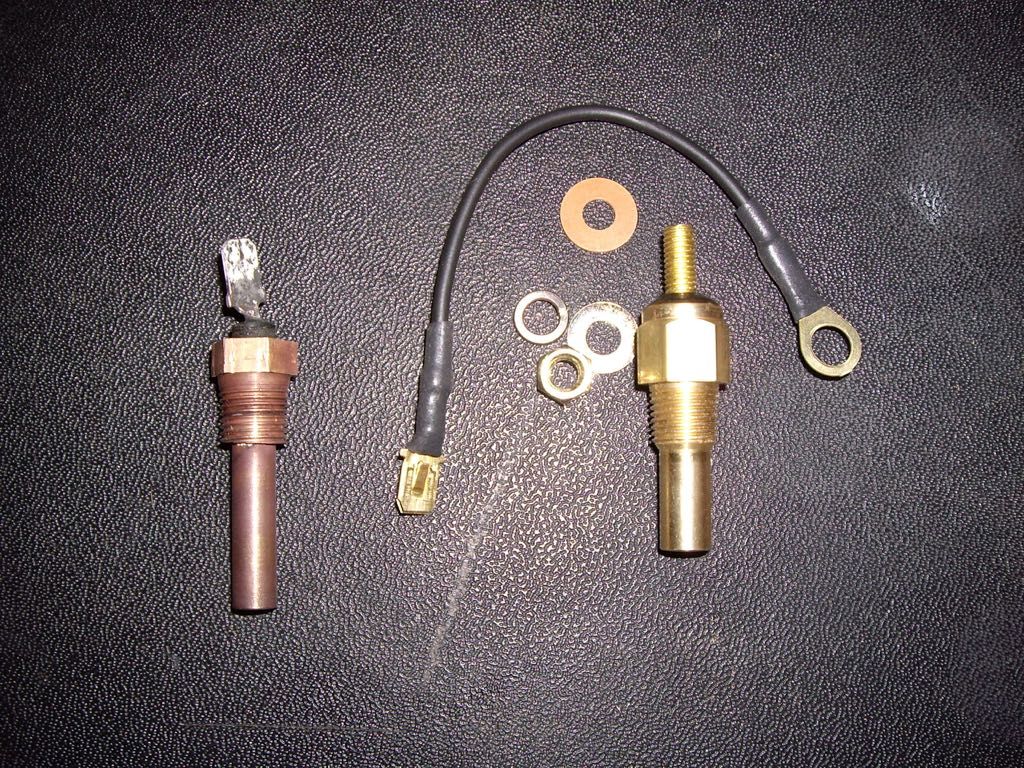
You can also see the old sensor on this photo. The internal sensor component is soldered in to the base and the top which is a bad idea. This is possibly why they fail - it should be welded, brazed or crimped.
So - the electrical characteristics. I measured this sensor:
0 degrees: 3230 ohms
100 degrees: 90 ohms
As above, the original sensor I measured gave:
0 degrees: 410 ohms
100 degrees: 700 ohms
I also did a few tests on 13379 to see what the dash was expecting from the sensor:
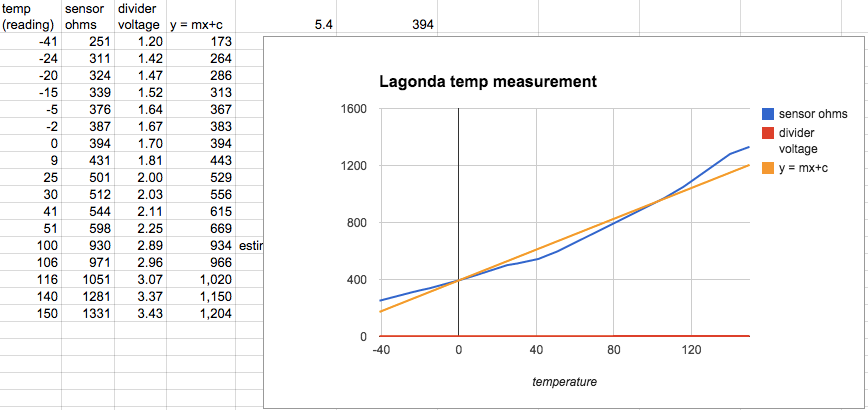
So actually the dash is slightly non-linear, but also this car has been set up for a sensor reading slightly higher resistance at 100 degrees (or there has been some drift over time since it was calibrated to the sensor).
So, I fitted the TIM sensor and sure enough, you get negative readings. In order to calibrate the dash to the sensor I made some wires with resistors in them. For 100 degrees you need 90 ohms so I made one with this, and one with 3230 ohms. I acatually made one for the standard sensors too and used it on the oil temp input to calibrate this:
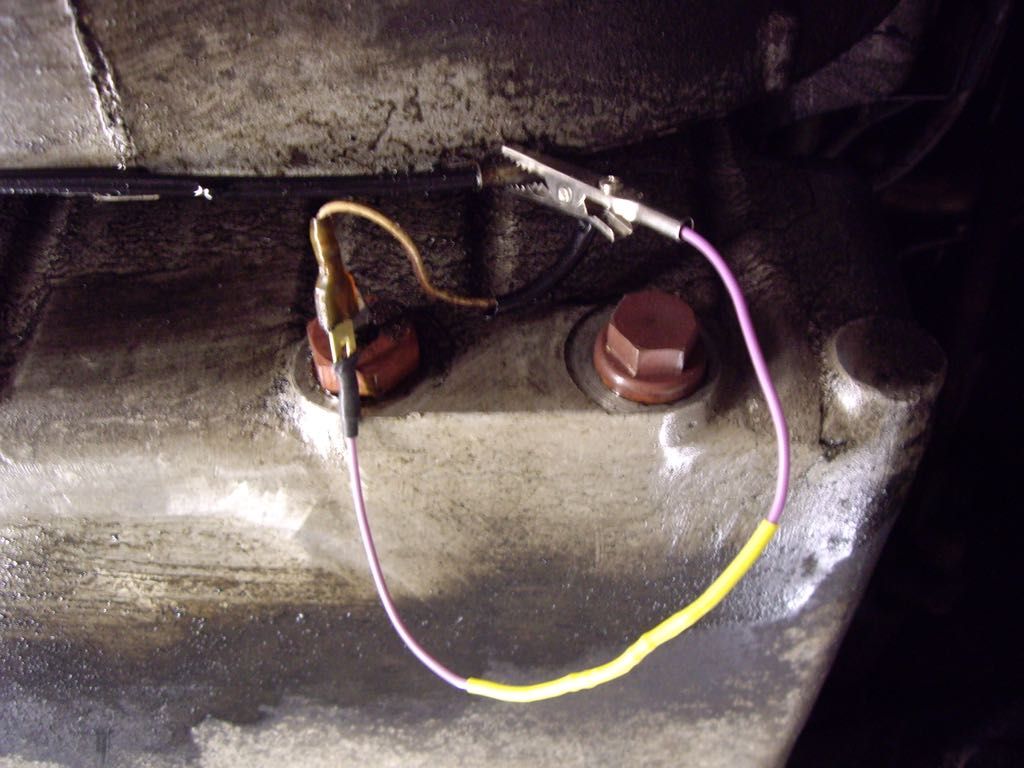 |
|
| Back to top |
|
 |
jonc
Joined: 21 Sep 2010
Posts: 584
Location: Cheshire, UK
|
 Posted: Sun Mar 29, 2015 1:14 pm Post subject: Posted: Sun Mar 29, 2015 1:14 pm Post subject: |
 |
|
So, the dash has one adjustment for the temperature readings which is to the right of each display. You can calibrate the 'deflection' but have no control over the zero point. Zero is defined as essentially 400 ohms in all cases.
This means that although you may be able to set an accurate (although negative) reading at one point, which would be 85 degrees, you will get meaningless readings the rest of the time. I suppose these will be consistent and so you will get used to them though - 400 ohms is probably something like 50 degrees engine temp, so the reading will go from something like + out-of-range at cold, all the way down via +199 to zero and then to minus 85 at operating temp.
I thought I would see if I could make some improvements to this. Firstly, at 100 degrees the sensor resistance is out of spec for the circuit. The readout works using a single chip which takes a voltage input, and displays that measurement in much the same way as a digital volt meter. The chip input range is defined as from 0.5V up from the lowest power supply to 0.5V below the high power supply. The chip operates on a regulated 6V, and the pull-up resistor on the input is 1k ohms. At 90 ohms (100 degrees), this would give 0.495V - just out of spec and certainly any temp above this would create a lower voltage. A resistance in series with the sensor would improve this - say 100 ohms.
Secondly, adjustment of the zero point. If this can be adjusted, you can get deflection from zero at zero degrees to -100 at 100 degrees and so meaningful readings.
Here is my modification:
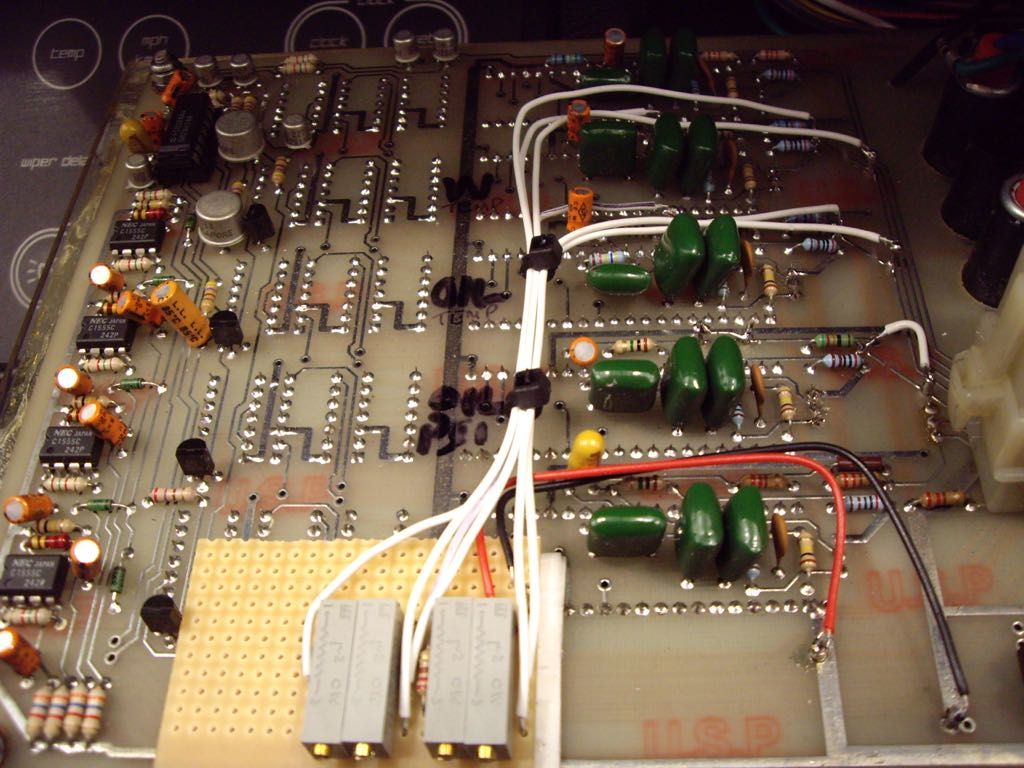
It is a piggy-back board with 20-turn trimmers. Of each pair (oil temp/water temp) there is a trimmer for the sensor series resistor and one for the zero setting. In some places tracks on the board needed to be cut, and so the connections are made using 1mm vero-pins which are inserted through 1mm drilled holes and soldered in place. This is a much more reliable method than soldering straight onto the tracks which risks them lifting.
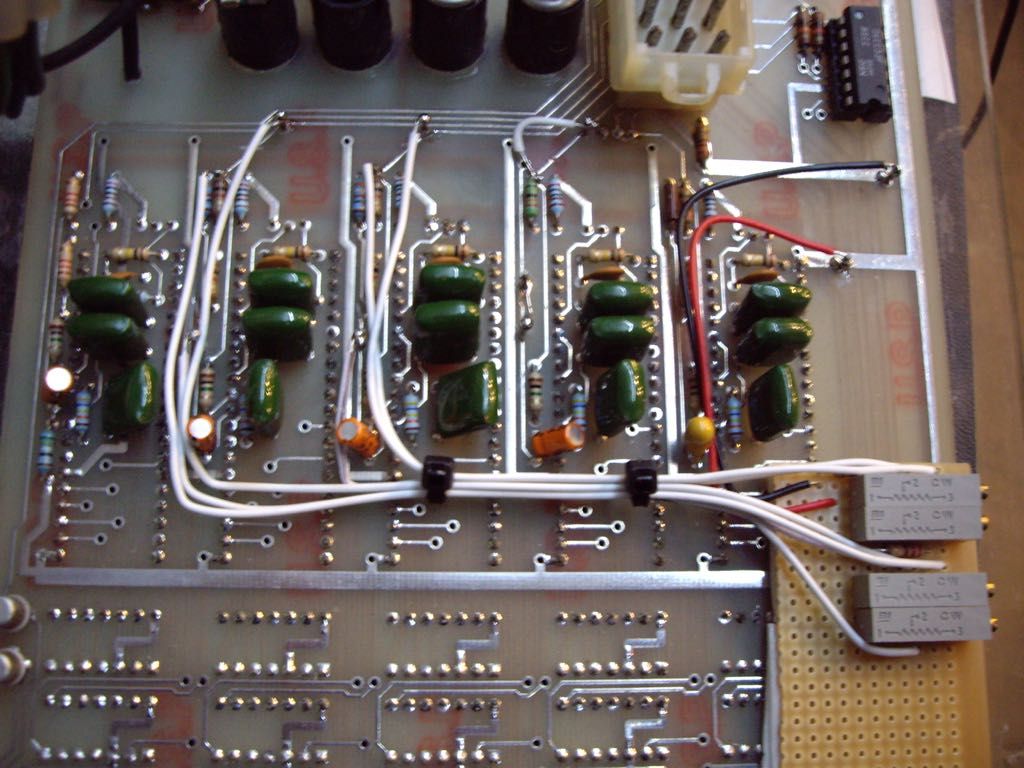 |
|
| Back to top |
|
 |
jonc
Joined: 21 Sep 2010
Posts: 584
Location: Cheshire, UK
|
 Posted: Sun Mar 29, 2015 1:20 pm Post subject: Posted: Sun Mar 29, 2015 1:20 pm Post subject: |
 |
|
So - setting up is done with two known resistor looms inserted instead of the sensor. But first, the sensor series trimmer is set at the mid point for 100 ohms to prevent the out-of-range at high temp. Then the zero degrees setting - with the zero degrees known resistor in place of the sensor the zero trimmer is adjusted to zero the display.
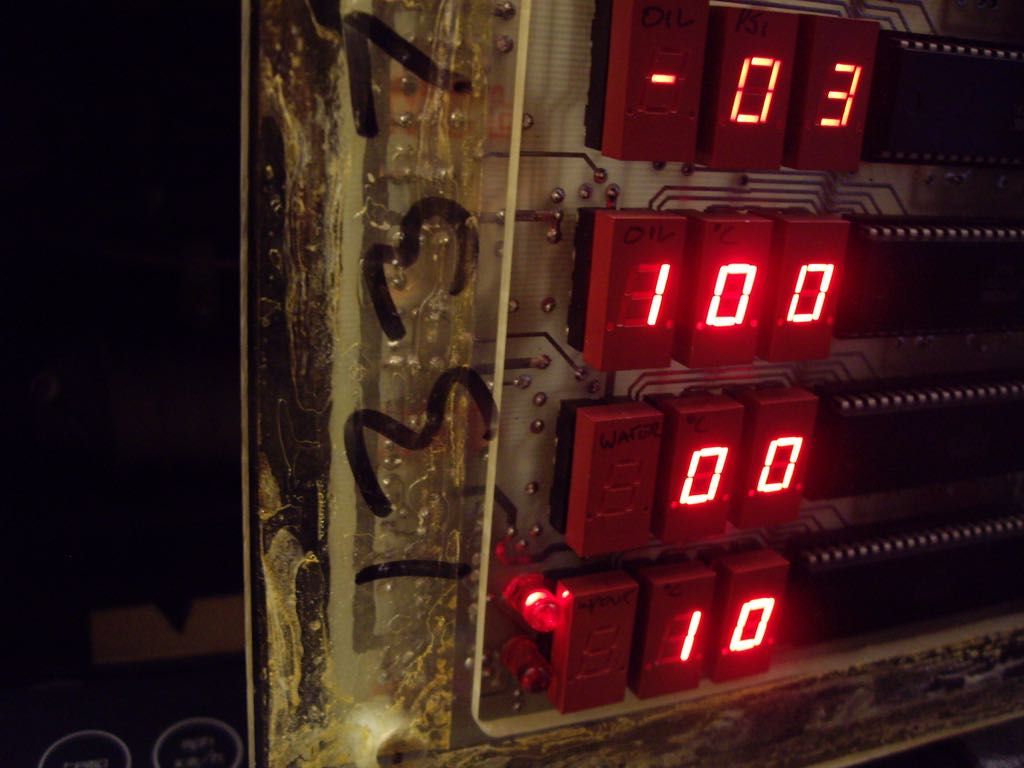
Next, the 100 degrees resistor is put in place of the sensor and the deflection setting is adjusted to display -100 degrees. Here you can see I have replaced the 270 degree trimmers with multi-turn ones which are easier to set accurately:
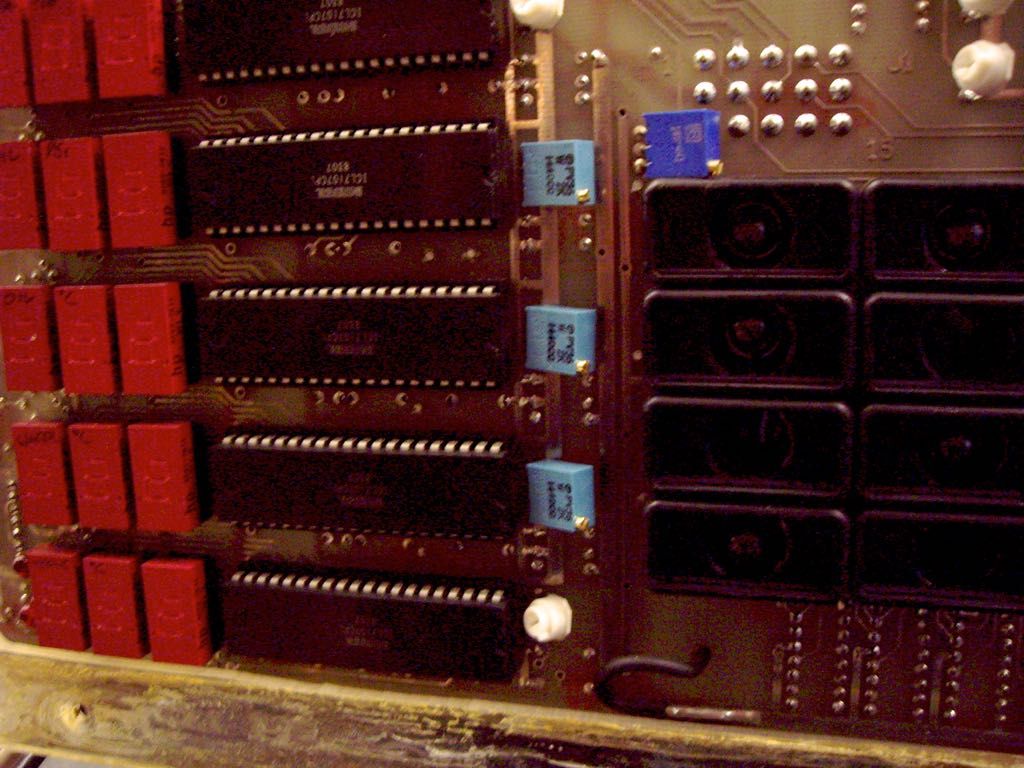 |
|
| Back to top |
|
 |
jonc
Joined: 21 Sep 2010
Posts: 584
Location: Cheshire, UK
|
 Posted: Sun Mar 29, 2015 1:26 pm Post subject: Posted: Sun Mar 29, 2015 1:26 pm Post subject: |
 |
|
So - does it work?
I put in the sensor. Ambient temperature was 18 degrees in the garage.
The reading - minus 58 degrees. Hmm.. not what I was expecting. I plotted it:

And the reason became obvious - the TIM sensor is a thermistor, and they are non-linear. But the display is expecting a linear response from the sensor. |
|
| Back to top |
|
 |
jonc
Joined: 21 Sep 2010
Posts: 584
Location: Cheshire, UK
|
 Posted: Sun Mar 29, 2015 4:10 pm Post subject: Posted: Sun Mar 29, 2015 4:10 pm Post subject: |
 |
|
So..
We are back to the drawing board with the sensors. With a few small improvements to the electronics, the dash can be made to work with a different sensor (and there is also a simple way to reverse the deflection so the negative can be turned into a positive one) but it needs to be linear. I went looking at sensors again and came across this diagram:
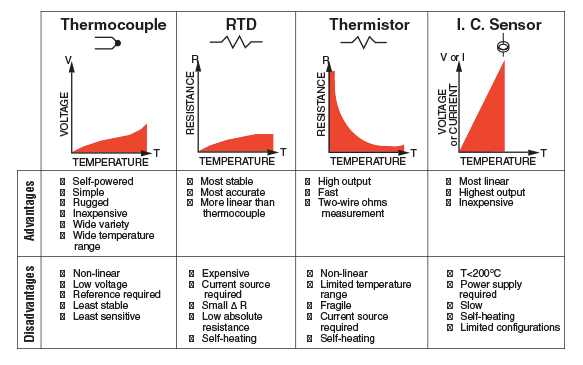
It is from manufacturer Omega's website, talking about their IC-based sensors: http://www.omega.com/prodinfo/integrated-circuit-sensors.html
We are looking for a resistance-based sensor really - that is what is there at the moment. An IC based one would do, but would be a three-wire sensor and would require a power supply to be fed to it. The RTD ones look the best for our application - this is the type used originally. I am thinking along the lines of a platinum resistance thermometer.
I took apart the TIM sensor to have a look at its construction:
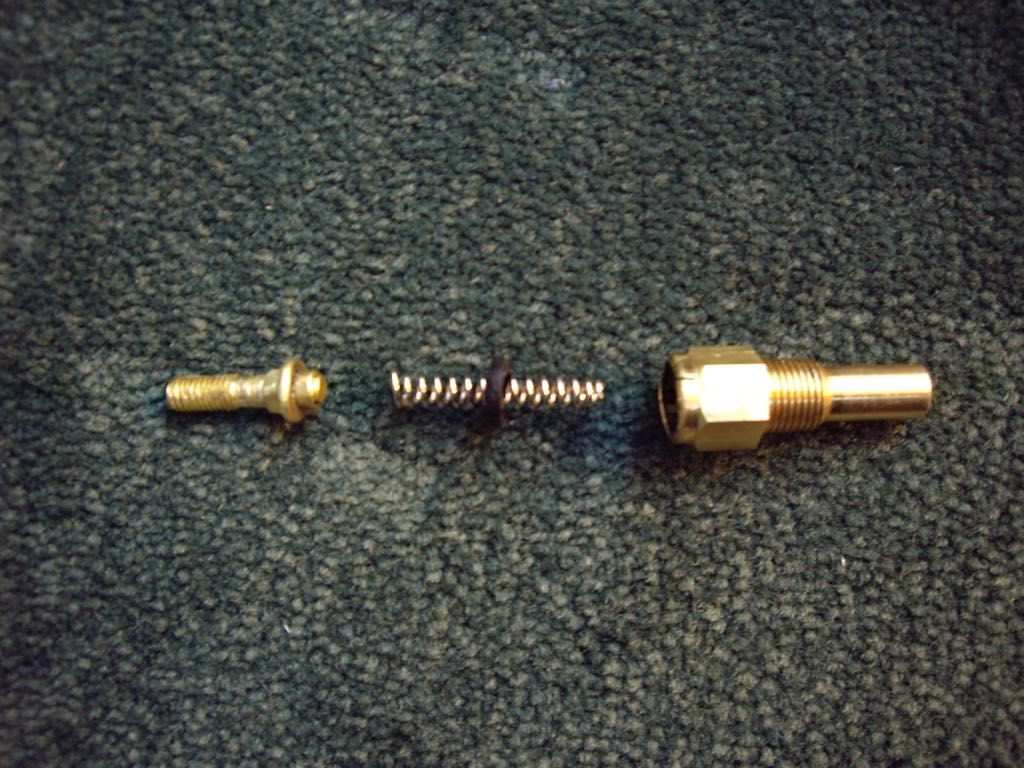
The threaded post connects to a spring which connects to a bead thermistor at the bottom of a 6.5mm diameter hole. This got me thinking about pre-packaged PT1000 sensors which come with a long wire, and a sensor inside a stainless steel capsule which happens to be 6mm diameter. I bought one and trimmed down the cable:
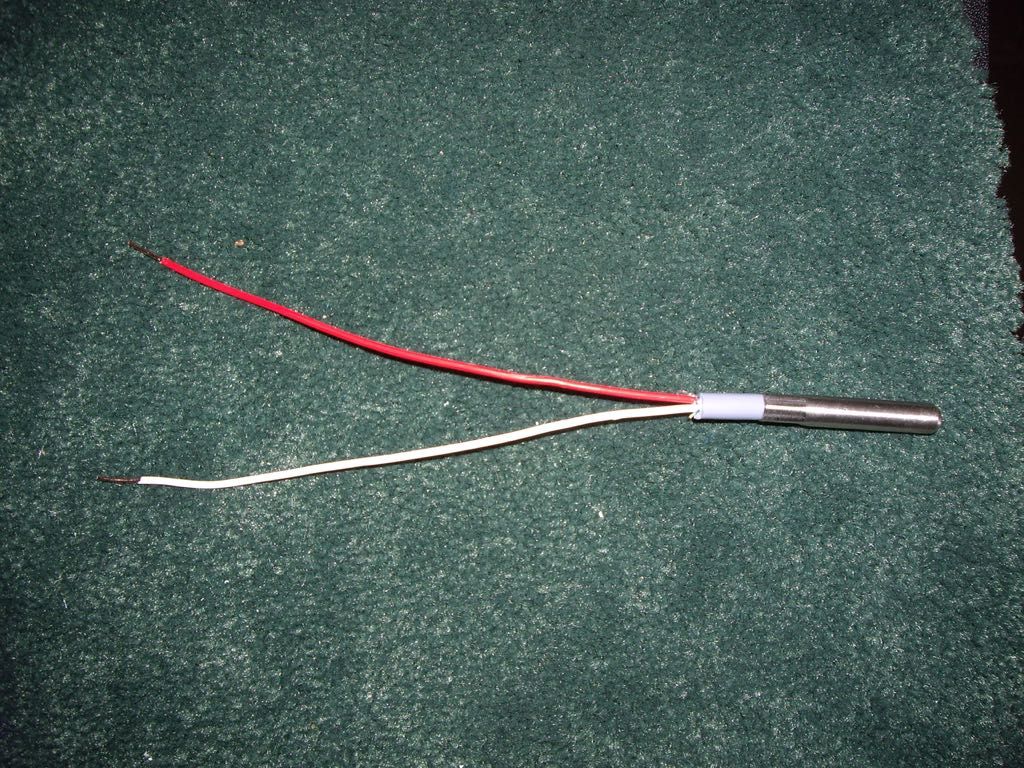
The characteristics are very well defined for these sensors:
Zero degrees: 1000 ohms
100 degrees: 1385 ohms.
I made up a couple of resistor leads with these set-points and also terminated the sensor with crimps and made the wires more resilient with adhesive lined heat-shrink:
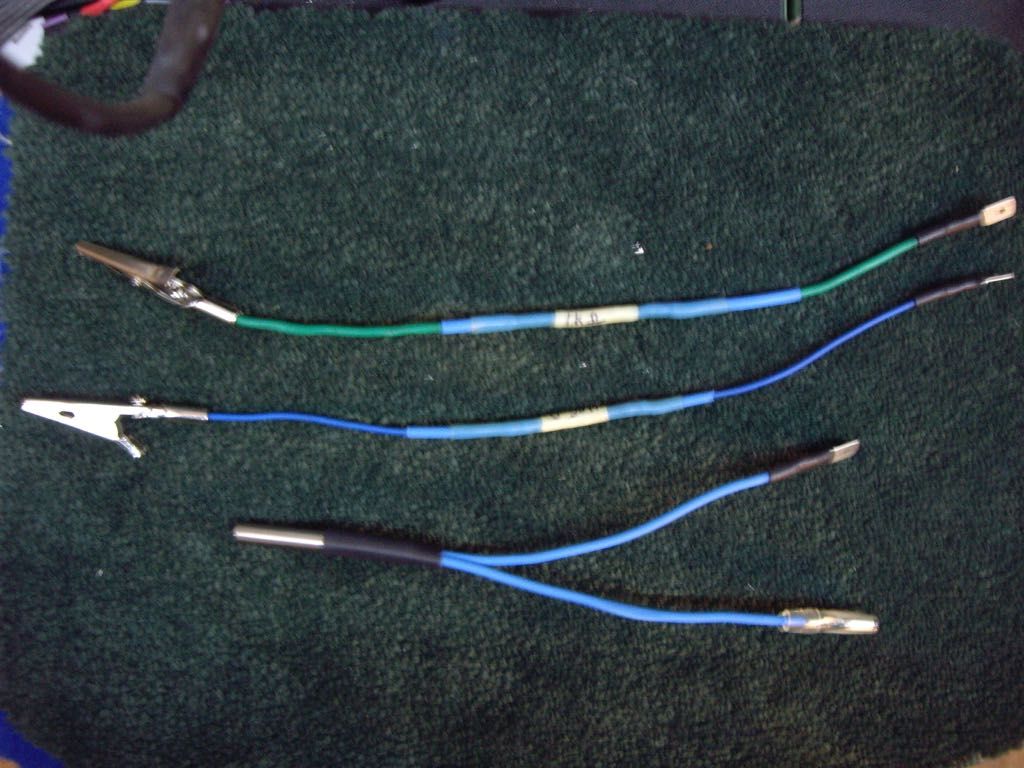
The sensor slides inside the TIM housing after it is fitted to the engine and has some heat-transfer grease which also helps keep it in place. The sensor needs a ground which I connected to nearby.
I found that the deflection calibration does not have the range to allow for the higher resistance of this sensor (remember 100 degrees was 700 ohms whereas this is 1385 ohms meaning a higher voltage input. This can be corrected by altering the resistor feeding this control. It is 1k and by soldering another 1k in parallel on top of it you get the required range and can set up the 100 degree set-point. I did this for both the oil and water circuits although I am still using the original oil temp sensor. At some point in the future this will need changing, and it proves that my changes still allow for original sensors.
Last edited by jonc on Sun Mar 29, 2015 4:18 pm; edited 1 time in total |
|
| Back to top |
|
 |
jonc
Joined: 21 Sep 2010
Posts: 584
Location: Cheshire, UK
|
 Posted: Sun Mar 29, 2015 4:15 pm Post subject: Posted: Sun Mar 29, 2015 4:15 pm Post subject: |
 |
|
Final checking. This is during engine warm-up so the oil is still much colder than the water (18 psi - oil pressure, 46 degrees oil temp, 82 degrees - water temp, 08 degrees - inside temp):
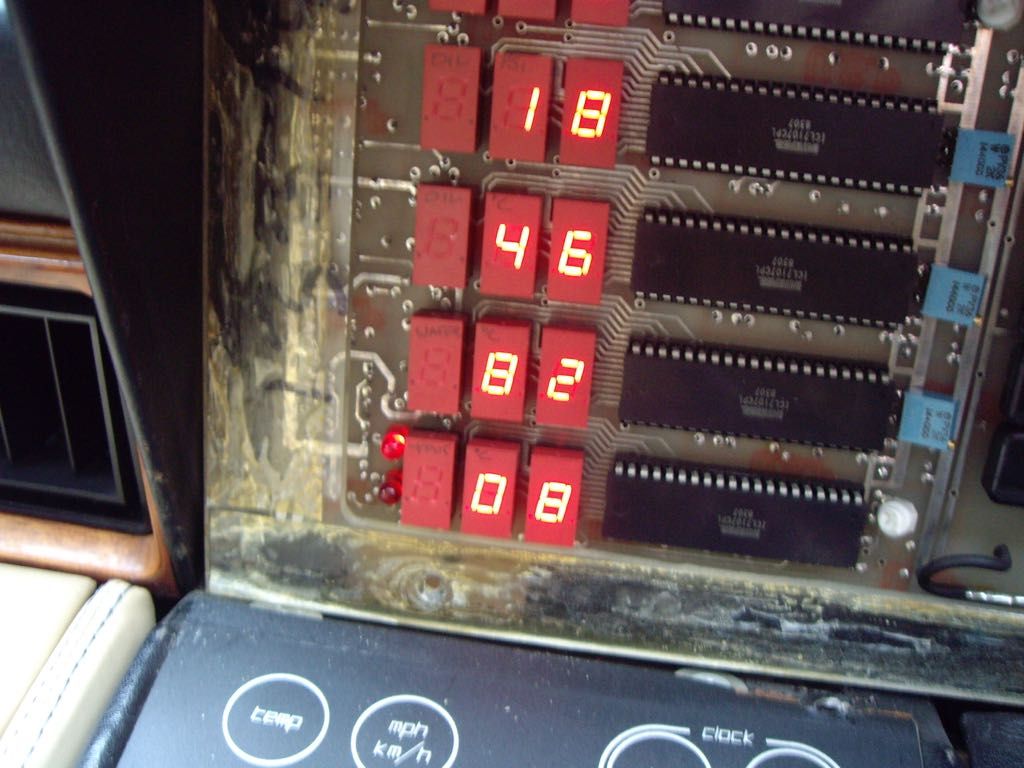
I am checking the water temp on the thermostat housing:
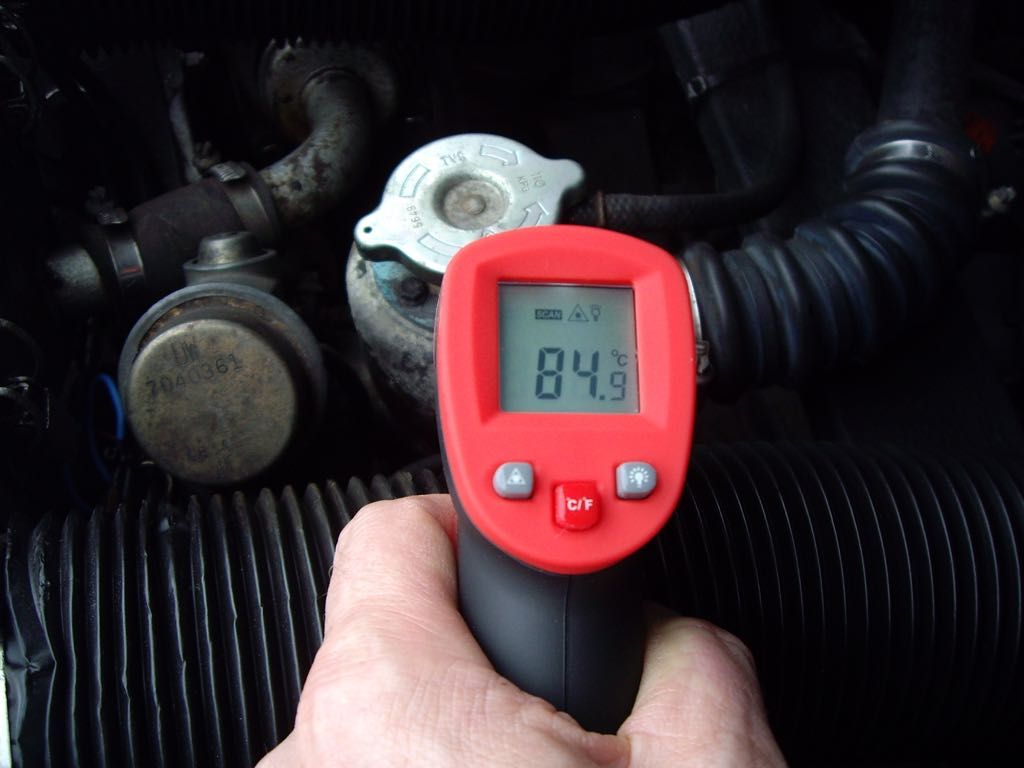
Having set the 100 degree point, the temp at 85 degrees is within two degrees (and I am testing at a slightly different point on the engine).
Last edited by jonc on Wed Apr 08, 2015 6:52 pm; edited 1 time in total |
|
| Back to top |
|
 |
jonc
Joined: 21 Sep 2010
Posts: 584
Location: Cheshire, UK
|
 Posted: Sun Mar 29, 2015 4:23 pm Post subject: Posted: Sun Mar 29, 2015 4:23 pm Post subject: |
 |
|
To sum up, only the AML sensor can be fitted if you expect readings accurate at more than one temperature without circuit modifications.
A PT500 sensor in a stainless steel housing would be the best choice as it would not require the final modification I made for the 100 degree set-point, although this change causes no harm and makes the dash more versatile to different sensor characteristics.
The PT1000 sensor was about £30. This cost is on top of the TIM sensor (for the housing) and the circuit mods (parts cost about £10). |
|
| Back to top |
|
 |
jonc
Joined: 21 Sep 2010
Posts: 584
Location: Cheshire, UK
|
 Posted: Wed Dec 09, 2015 10:06 am Post subject: Posted: Wed Dec 09, 2015 10:06 am Post subject: |
 |
|
I have simplified the modifications slightly for 13277. Firstly, the calibration trimmer for each reading - this is a 2k ohm variable resistor with a resistor on the board at each end to restrict the voltage range. Above I found that when using a PT1000 it did not provide enough voltage and so I had to reduce the resistor to the +6v power supply rail. I have simplified this by replacing the 2k ohm trimmer with a 5k ohm one which gives the required voltage range without the need for altering any resistors on the board.
Secondly, the zero trimmers - I have made these 5k also, and with 22 turns there is enough range without the need for any resistors to limit the voltage across them. This means one end of the trimmer is ground and the other +6V. Here I have the piggy-back board with a full set:

After I made this I realised that they are not needed for the revs or speed since at zero input (engine stopped or stationary) the input is zero volts and so they are wired for this anyway. If you have a reading which is not zero, you have a different problem!
Final point - sourcing the PT1000 sensors.
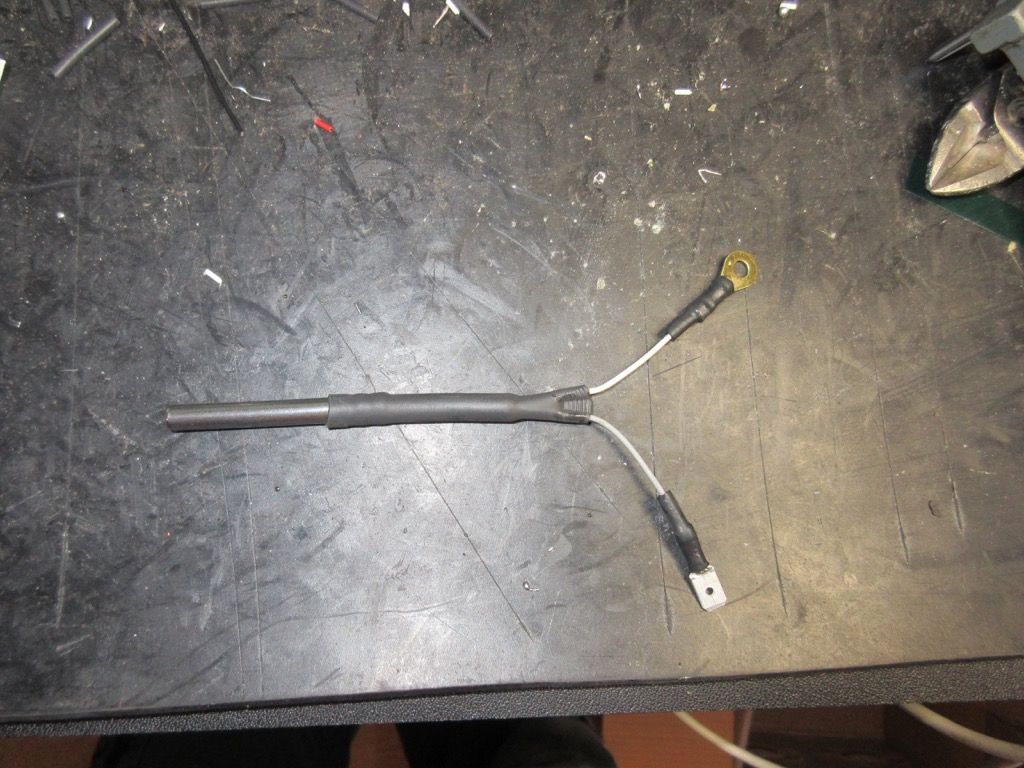
These are a standard part used in solar hot water installations to sense solar collector and hot water tank temperatures. They come with a lead of a metre or so which you cut down and terminate. Resol make a solar controller and so if you search for "Resol PT1000 sensor" you will find them. There are a number of companies on Amazon selling them for around £10.
Any PT1000 sensor has exactly the same electrical characteristics we are looking for. The solar ones in the 6mm stainless steel capsule are a commodity item and so are very cheap. They also seem very reliable. I have them in a solar system and the outside one on the collector experiences temperature swings every day from 10 degrees to 120 degrees and is exposed to the elements. It has run faultlessly for four years so far. |
|
| Back to top |
|
 |
Lagondanet
Administrator

Joined: 03 Jan 2007
Posts: 3110
Location: UK
|
 Posted: Wed Dec 09, 2015 11:51 am Post subject: Posted: Wed Dec 09, 2015 11:51 am Post subject: |
 |
|
| Another masterclass! |
|
| Back to top |
|
 |
|



















